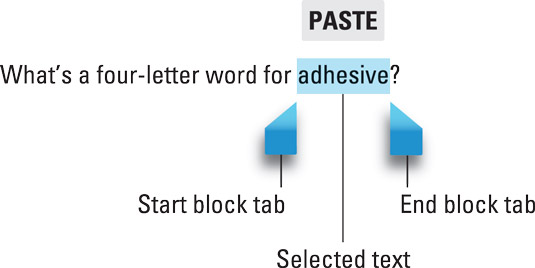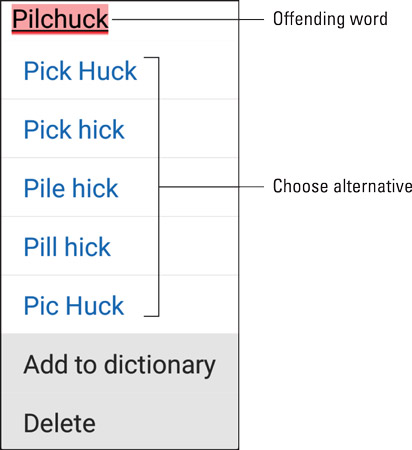You probably won’t do a lot of text editing on your Android phone. Well, no major editing, such as for a term paper or ransom note. From time to time, however, you may find yourself wanting to fix a word. It’s usually a sign that you’re over 25; kids no longer seem to care about editing text.
Moving the cursor
The first part of editing text is to move the cursor to the right spot. The cursor is that blinking, vertical line where text appears. Then you can type, edit, or paste or simply marvel that you were able to move the cursor hither and thither.
On a computer, you move the cursor by using a pointing device. If your Android phone features a pointing device, such as a thumb ball or arrow keys on a physical keyboard, you can use that device to move the cursor while you edit text. Otherwise, your finger performs the cursor-moving task.
Tap the spot on the text where you want the cursor to appear. To help your accuracy, a cursor tab appears below the text. You can move that tab with your finger to precisely locate the cursor in your text.
After you move the cursor, you can continue to type, use the Delete key to back up and erase, or paste text copied from elsewhere.
You may see a pop-up button by the cursor tab containing a Paste action. Use that button to paste text.
Selecting text
Selecting text on an Android phone works just like selecting text in a word processor: You mark the start and end of a block. That chunk of text appears highlighted on the screen. How you get there, however, can be a mystery —until now!
To select text, long-press a word. Upon success, you see a chunk of text selected.

Drag the start and end markers around the touchscreen to define the block of selected text.
While text is selected, a contextual action bar appears atop the screen. Your phone may sport a custom action bar with a different look. Either way, you use the action bar to deal with the selected text.

To delete a selected block of text, tap the Delete key on the onscreen keyboard. To replace the text, type something new.
To cancel text selection, tap the Done icon on the action bar, or just tap anywhere in the text outside the selected block.
If long-pressing doesn’t select a word, try double-tapping the word.
Selecting text on a web page works the same as selecting text in any other app, although you might try long-pressing and not double-tapping. The difference is that text can only be copied from the web page, not cut or deleted.
Seeing the onscreen keyboard is a good indication that you can edit and select text.
The action bar’s Select All command can be used to mark all text as a single block.
Cutting, copying, and pasting text
Selected text is primed for cutting or copying, which works just like it does in your favorite word processor. After you select the text, choose the proper command from the contextual action bar. To copy the text, choose the Copy command. To cut the text, choose Cut.
Just like on your computer, cut or copied text on your phone is stored in a clipboard. To paste any previously cut or copied text, move the cursor to the spot where you want the text pasted. Tap the Paste button.
A quick way to paste text is to look for the Paste button above the cursor tab. To see that button, tap anywhere in the text. Tap the Paste command button to paste in the text.
Some phones feature a Clipboard app, which lets you peruse, review, and select previously cut or copied text or images. You might even find the Clipboard icon on the action bar or onscreen keyboard.
You can paste text only into locations where text is allowed. Odds are good that if you see the onscreen keyboard, you can paste text.
Dealing with spelling errors
Similar to a word processor, your Android phone may highlight misspelled words, presenting them with an intimidating red underline.
To remedy the situation, tap the red-underlined word. You see a pop-up list of alternatives. Tap a replacement or, if the word is correctly spelled but unknown to the phone, choose to add the word to a personal dictionary.

Words may be autocorrected as you type them. To undo an auto-correction, tap the word again. Choose a replacement word from the predictive-text list, or tap the Replace button to see more options.
Yes! Your phone has a personal dictionary.





